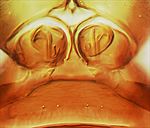
Female

Female (mature)

Female

Head and pronotum

Head and thorax

Head & thorax

Hind coxae

Forewing

Antenna

Forewing
Link to genera & species of Australian Panchaetothripinae
Diagnostic characters
Membership of this subfamily of Thripinae is usually based on the presence of strong reticulation on the head, thorax and fore femora, and the close position of the fore wing first vein to the costa (Wilson, 1975). However, Zhang et al. (2019) recognised three morphological synapomorphies for this group: presence of a second, long sense cone on antennal segment IV; lack of a discal seta on the fore wing clavus; presence of two extra pairs of setae near the posterior margin of sternite VII. Within the subfamily, there is great variation in the form of the fore wing and in the degree of development of the metathoracic endofurca. In many species the second instar larva has abdominal segment X prominently tubular with long anal setae.
Diversity
Worldwide, there are 42 genera and 145 species listed in the Panchaetothripinae (ThripsWiki, 2020), with 17 genera and 25 species recorded from Australia (ABRS, 2020).
Distribution data
Most Panchaetothripinae are from the Old World tropics, with only a few genera and species known from the Americas.
Biological data
These species all breed on leaves, usually on older leaves rather than on young emerging leaves, and a few are associated with ferns or with the leaves of Poaceae.
References
Australian Biological Resources Study. https://biodiversity.org.au/afd/taxa/Panchaetothripinae/statistics
ThripsWiki (2020) ThripsWiki - providing information on the World's thrips. Available from: http://thrips.info/wiki/Main_Page [accessed 29.x.2019].
Zhang SM, Mound LA & Feng JN (2019) Sub-family relationships of Bradinothrips Hood and Parascolothrips Mound (Thysanoptera, Thripidae). Zootaxa 4590 (5): 587–593.